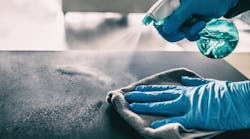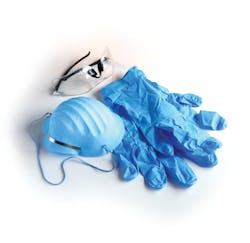Environmental disinfection is a vital step toward preventing the spread of COVID-19
Dental professionals should be well versed in the importance of protecting patients, staff, and anyone else who enters the practice from infection. The pandemic has brought the importance of practicing good hand hygiene and the use of proper personal protective equipment into sharp focus, but it is also essential to scrutinize every aspect of the clinic. There is no better time to confirm that everyone is adhering to standard precautions, and that includes proper environmental infection control.
I know I am preaching to the choir when I mention the necessity of disinfecting all surfaces, paying particular attention to those of clinical importance.1 However, many may not realize that using a product incorrectly or lacking adequate time to thoroughly clean between patients could put a practice’s standards at risk. Preventing the spread of pathogens through environmental infection control is a crucial part of any dental practice.2
Preventing health-care-associated infections (HAIs) is the name of the game in any medical environment.3 Here are some ways to ensure that everyone is providing safe dental visits and performing proper environmental infection control.
When choosing disinfectants, cost is just one factor to consider
Finances are a very important consideration when it comes to the success of a dental practice. However, when choosing products to disinfect, cost is one factor, but there are a few others to keep in mind. One issue that comes up time and time again is incorrect usage of disinfectants. Failure to follow directions on the packaging or using a product that is inappropriate for a certain surface or piece of equipment are just two examples of improper usage.
It goes without saying that it is vital to use a disinfectant approved by the EPA, and one that kills as many pathogens as possible. According to the Centers for Disease Control and Prevention (CDC), a disinfectant’s ability to kill Mycobacterium tuberculosis (M. tb) is one benchmark, as M. tb is a notoriously difficult microorganism to destroy.4
When choosing a product, select one that is hypoallergenic, odorless, nontoxic, and fast acting.5 These considerations aside, having the right product on hand is only the start of the process. Ensuring it is used correctly is the responsibility of everyone in the clinic.6
Whether the office decides to use wipes or towelettes or a spray, adhering to the proper process is key. Clearing the surface of debris and other objects should be completed prior to use of the disinfectant; then it’s crucial to follow the manufacturer’s instructions.7 The team also needs to understand the contact time required for each chemical to work, whether there is more than one step to the process, and the correct method of spreading the product (e.g., spray onto the surface and wipe or soak gauze or paper towel in the product and then wipe). Unfortunately, the instructions for use are not always black and white. Some products may list the required contact time for cleaning as two minutes, yet if you continue reading, they will give an extended contact time for disinfecting, and an even longer contact time for killing viruses versus bacteria. Understanding the necessary contact time is critical because this will be instrumental in deciding how much time will be needed to turn the room over between patients. Keep in mind, the surface must dry before placing barrier wraps or setting up the room. That’s right; if the kill time or contact time is five minutes to properly disinfect the surfaces, it’s necessary to wait until the product has dried before setting up the room. When you say you have an hour per patient, remember that includes the time it takes to properly turn over a room.
Taking shortcuts such as having gauze already soaking may be considered incorrect usage by the manufacturer. Protect the clinic and the patient by following the correct procedures at all times.
PPE isn’t just for patient care
The lack of use and/or misuse of PPE has made headlines recently due to COVID-19 and is something that many are taking the opportunity to reassess and perfect.
Making sure that the entire team has adequate coverage and knows the correct use and procedures around PPE will help promote a safer environment for all.8 But remember, PPE isn’t just for protection when treating a patient. PPE should always be in place when clinicians use chemicals; it prevents destruction of the mucus lining in the nasal passage due to inhalation, and shields eyes from chemical splashes.9
With the general public and health professionals more focused than ever on preventing the spread of infection, now is the perfect time to evaluate your environment and upgrade processes and products where necessary.It can’t be stated enough: reading product instructions will point clinicians in the right direction. Does the manufacturer recommend wearing a mask to prevent inhalation? Are eye-protection shields required? Should thick utility gloves be worn to protect the skin? If utility gloves are recommended, exam gloves will not suffice. Following EPA guidelines is necessary at all times; in case of an incident, check the instructions for use to find out what first aid or intervention is needed.
Follow all instructions on PPE maintenance and cleaning to the letter and ensure that the products used are suitable for face shields, eyewear, and other reusable items. Some equipment may require specific levels of alcohol, so make sure to know what is in the disinfectant in order to preserve the life of the equipment and avoid having to buy new equipment unnecessarily.6
How to improve environmental hygiene
To help eradicate errors when using disinfectants, consider drafting a standard operating procedure (SOP) that clearly communicates the processes to follow and defines safety instructions in a transparent and easy-to-follow manner. In creating such an SOP, you remove uncertainty and help the team achieve higher levels of patient safety. If an SOP already exists, confirm that it is updated and that it meets requirements for the current pandemic.10
Your SOP should lay out the basics of proper infection prevention and make each team member acutely aware of the part they play in maintaining a safe environment. Holding each person accountable for their behavior and ensuring meticulous adherence to all guidelines will help to create a culture of trust and allow for coherent communication at all levels.
Be sure to identify the items that cannot be cleaned and disinfected well or at all. Technology can be an issue here. If it can’t be cleaned and disinfected, it must be barrier wrapped or removed from the operatory.1 In fact, barrier wraps are a great idea for all items that have nooks and crannies that are difficult or time-consuming to clean, and they can help decrease the amount of chemicals needed to reprocess the operatory. Barrier wraps should be fluid resistant and FDA approved. They are for one-time use and must be changed between patients. Also keep in mind that if the surface becomes contaminated, even with use of the barrier wrap, the surface will need to be cleaned and disinfected. This can happen if a barrier is cumbersome or difficult to remove without contaminating the surface. If this is a concern, it may be advantageous to consider other barrier wrap options that would be easier to remove or provide a better fit, or even other instruments that are easier to clean and disinfect and therefore would eliminate the need for a barrier. Take a look at the items being used in the office and examine if these are easy to clean or have nooks and crannies that could harbor microbes. If the operatory has an older unit that doesn’t have smooth surfaces, consider barrier wrapping the unit to help decrease the time it takes to clean and disinfect. Barriers come in all shapes and sizes to best fit many types of units.
One other often neglected factor in a busy dental practice is cleaning and disinfecting treatment rooms between patients. When booking appointments, adequate time must be allowed between patients for a thorough reprocessing. Using disposable barriers could save time in the cleaning and disinfecting process depending on the contact time of the product being used. It’s smart to time how long the process of performing environmental infection control takes, and go from there. As a team, examine possible ways to save money and ideas for ways to turn over rooms more effectively and efficiently.
Tips for implementing and maintaining proper environmental disinfection practices
Read the instructions associated with all equipment in the operatory. It may seem overwhelming at first, but it’s important to know what products are recommended for all equipment and surfaces. Using the wrong chemicals can deteriorate the equipment and lead to unnecessary expense.With the general public and health professionals more focused than ever on preventing the spread of infection, now is the perfect time to evaluate your environment and upgrade processes and products where necessary. If it is not possible to adequately clean and disinfect an item, it needs to be removed or covered.1 Preventing HAIs is every health professional’s responsibility; make sure you’re doing your part.
References
- Gebel J, Exner M, French G, et al. The role of surface disinfection in infection prevention. GMS Hyg Infect Control. 2013;8(1):Doc10. doi:10.3205/dgkh000210
- Environmental surface disinfection: CDC’s guidelines for dental offices—simplified. April 3, 2018. Accessed May 24, 2020. https://tdaperks.com/environmental-surface-disinfection-cdcs-guidelines-for-dental-offices-simplified/
- Mupparapu M, Kothari KRM. Review of surface disinfection protocols in dentistry: a 2019 update. Quintessence Int. 2019;50(1):58-65. doi:10.3290/j.qi.a41337
- Cleaning & disinfecting environmental surfaces. Centers for Disease Control and Prevention. Accessed May 24, 2020. https://www.cdc.gov/oralhealth/infectioncontrol/faqs/cleaning-disinfecting-environmental-surfaces.html
- Molinari JA, Nelson P. Environmental surface cleaning and disinfection: Effects of alcohol concentration. January 2016. Accessed May 24, 2020. https://www.dentaladvisor.com/pdf-download/?pdf_url=wp-content/uploads/2016/01/TTS27-Caviwipes-Final.pdf
- Chemical disinfectants: Guideline for disinfection and sterilization in healthcare facilities (2008). Accessed May 24, 2020. https://www.cdc.gov/infectioncontrol/guidelines/disinfection/disinfection-methods/chemical.html
- Environmental surface disinfectants: Critical information. TRAC Research. February 2015. Accessed May 24, 2020. https://hinman.org/Clinicians/Handouts/2017/Th302.pdf
- Guidance for dental settings. Centers for Disease Control and Prevention. Updated June 17, 2020. Accessed May 24, 2020. https://www.cdc.gov/coronavirus/2019-ncov/hcp/dental-settings.html
- Keeping yourself safe and healthy: Choose, then use PPE. RDH. January 1, 2006. Accessed May 24, 2020. https://www.rdhmag.com/infection-control/personal-protective-equipment/article/16409159/keeping-yourself-safe-and-healthy-choose-then-use-ppe
- Standard operating procedures and COVID-19. Group Dentistry Now. April 21, 2020. Accessed May 24, 2020. https://groupdentistrynow.com/dso-group-blog/standard-operating-procedures-and-covid-19/









